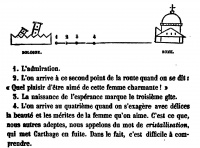Beauty is a promise of happiness
From The Art and Popular Culture Encyclopedia
(Difference between revisions)
| Revision as of 14:46, 22 May 2018 Jahsonic (Talk | contribs) ← Previous diff |
Revision as of 14:54, 22 May 2018 Jahsonic (Talk | contribs) Next diff → |
||
| Line 1: | Line 1: | ||
| {| class="toccolours" style="float: left; margin-left: 1em; margin-right: 2em; font-size: 85%; background:#c6dbf7; color:black; width:30em; max-width: 40%;" cellspacing="5" | {| class="toccolours" style="float: left; margin-left: 1em; margin-right: 2em; font-size: 85%; background:#c6dbf7; color:black; width:30em; max-width: 40%;" cellspacing="5" | ||
| | style="text-align: left;" |[[Immanuel Kant|Kant]]'s famous definition of the [[beauty|beautiful]]. "That is beautiful," says Kant, "which pleases without [[Interest (emotion)|interesting]]." Without interesting! Compare this definition with this other one [...] by [[Stendhal]], who once called the beautiful une ''[[Beauty is a promise of happiness|promesse de bonheur]]''. Here, at any rate, the one point which Kant makes prominent in the aesthetic position is repudiated and eliminated—le [[Disinterestedness|désinteressement]]. Who is right, Kant or Stendhal? --Nietzsche, ''[[On the Genealogy of Morality]]'' | | style="text-align: left;" |[[Immanuel Kant|Kant]]'s famous definition of the [[beauty|beautiful]]. "That is beautiful," says Kant, "which pleases without [[Interest (emotion)|interesting]]." Without interesting! Compare this definition with this other one [...] by [[Stendhal]], who once called the beautiful une ''[[Beauty is a promise of happiness|promesse de bonheur]]''. Here, at any rate, the one point which Kant makes prominent in the aesthetic position is repudiated and eliminated—le [[Disinterestedness|désinteressement]]. Who is right, Kant or Stendhal? --Nietzsche, ''[[On the Genealogy of Morality]]'' | ||
| - | <hr> | ||
| - | "Au fond, le livre ''[[On Love (Stendhal)|de L'Amour]]'' se résume en ceci : Les Français sont trop vaniteux; les Anglais sont trop orgueilleux et ont trop su, comme les anciens Romains, persuader à leurs femmes qu'elles doivent s'ennuyer; les Allemands, qui meurent d'envie d'avoir du caractère, sont trop rêve-creux, ils se jettent trop dans leurs imaginations et dans leur philosophie, espèce de folie douce, aimable, et surtout sans fiel. Les républicains d'Amérique adorent trop le ''dieu dollar''; il n'y a d'amour qu'en Italie." | ||
| |} | |} | ||
| [[Image:'Bologne to Rome' page in Stendhal's On Love.jpg|thumb|right|200px|[[Stendhal]]'s depiction of the process of [[falling in love]], from ''[[On Love (Stendhal) |On Love]]'', 1822]] | [[Image:'Bologne to Rome' page in Stendhal's On Love.jpg|thumb|right|200px|[[Stendhal]]'s depiction of the process of [[falling in love]], from ''[[On Love (Stendhal) |On Love]]'', 1822]] | ||
| {{Template}} | {{Template}} | ||
| '''"La beauté est une promesse de bonheur'''" (English: Beauty is a promise of happiness) is a dictum by [[Stendhal]]. It was first published as a footnote in his treatise ''[[On Love (Stendhal)|On Love]]'' (1822). | '''"La beauté est une promesse de bonheur'''" (English: Beauty is a promise of happiness) is a dictum by [[Stendhal]]. It was first published as a footnote in his treatise ''[[On Love (Stendhal)|On Love]]'' (1822). | ||
| + | |||
| + | The full note reads like this: | ||
| + | |||
| + | :"La beauté n’est que la promesse du bonheur. Le bonheur d’un Grec était différent du bonheur d’un Français de 1822. Voyez les yeux de la Vénus de Médicis et comparez-les aux yeux de la Madeleine de [[Il Pordenone|Pordonone]] (chez M. de Sommariva). [https://fr.wikisource.org/wiki/Page:Stendhal,_De_l’amour,_Lévy,_1853.djvu/64]" | ||
| It is often misattributed to [[Edmund Burke]]. | It is often misattributed to [[Edmund Burke]]. | ||
Revision as of 14:54, 22 May 2018
| Kant's famous definition of the beautiful. "That is beautiful," says Kant, "which pleases without interesting." Without interesting! Compare this definition with this other one [...] by Stendhal, who once called the beautiful une promesse de bonheur. Here, at any rate, the one point which Kant makes prominent in the aesthetic position is repudiated and eliminated—le désinteressement. Who is right, Kant or Stendhal? --Nietzsche, On the Genealogy of Morality |
|
Related e |
|
Featured: |
"La beauté est une promesse de bonheur" (English: Beauty is a promise of happiness) is a dictum by Stendhal. It was first published as a footnote in his treatise On Love (1822).
The full note reads like this:
- "La beauté n’est que la promesse du bonheur. Le bonheur d’un Grec était différent du bonheur d’un Français de 1822. Voyez les yeux de la Vénus de Médicis et comparez-les aux yeux de la Madeleine de Pordonone (chez M. de Sommariva). [1]"
It is often misattributed to Edmund Burke.
The title of Only A Promise of Happiness (2008) references the dictum.
Unless indicated otherwise, the text in this article is either based on Wikipedia article "Beauty is a promise of happiness" or another language Wikipedia page thereof used under the terms of the GNU Free Documentation License; or on research by Jahsonic and friends. See Art and Popular Culture's copyright notice.


